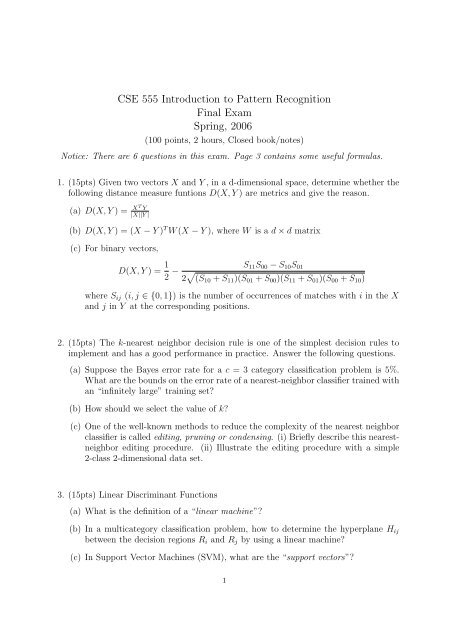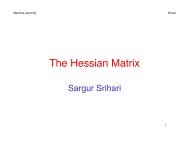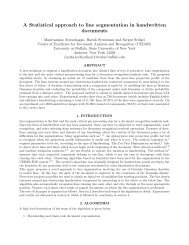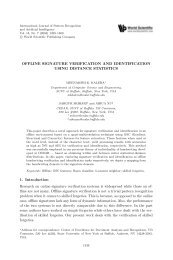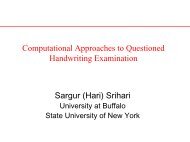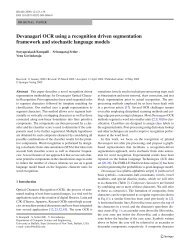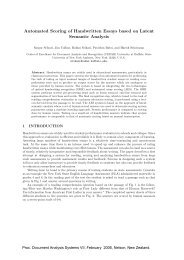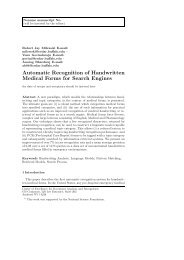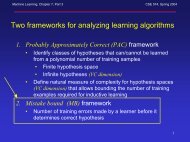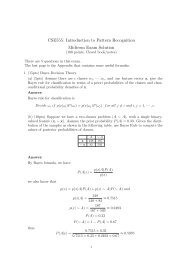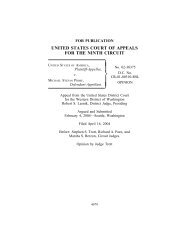CSE 555 Introduction to Pattern Recognition Final Exam ... - CEDAR
CSE 555 Introduction to Pattern Recognition Final Exam ... - CEDAR
CSE 555 Introduction to Pattern Recognition Final Exam ... - CEDAR
- No tags were found...
You also want an ePaper? Increase the reach of your titles
YUMPU automatically turns print PDFs into web optimized ePapers that Google loves.
<strong>CSE</strong> <strong>555</strong> <strong>Introduction</strong> <strong>to</strong> <strong>Pattern</strong> <strong>Recognition</strong><strong>Final</strong> <strong>Exam</strong>Spring, 2006(100 points, 2 hours, Closed book/notes)Notice: There are 6 questions in this exam. Page 3 contains some useful formulas.1. (15pts) Given two vec<strong>to</strong>rs X and Y , in a d-dimensional space, determine whether thefollowing distance measure funtions D(X,Y ) are metrics and give the reason.(a) D(X,Y ) = XT Y|X||Y |(b) D(X,Y ) = (X − Y ) T W(X − Y ), where W is a d × d matrix(c) For binary vec<strong>to</strong>rs,D(X,Y ) = 1 2 − S 11 S 00 − S 10 S 012 √ (S 10 + S 11 )(S 01 + S 00 )(S 11 + S 01 )(S 00 + S 10 )where S ij (i,j ∈ {0, 1}) is the number of occurrences of matches with i in the Xand j in Y at the corresponding positions.2. (15pts) The k-nearest neighbor decision rule is one of the simplest decision rules <strong>to</strong>implement and has a good performance in practice. Answer the following questions.(a) Suppose the Bayes error rate for a c = 3 category classification problem is 5%.What are the bounds on the error rate of a nearest-neighbor classifier trained withan “infinitely large” training set?(b) How should we select the value of k?(c) One of the well-known methods <strong>to</strong> reduce the complexity of the nearest neighborclassifier is called editing, pruning or condensing. (i) Briefly describe this nearestneighborediting procedure. (ii) Illustrate the editing procedure with a simple2-class 2-dimensional data set.3. (15pts) Linear Discriminant Functions(a) What is the definition of a “linear machine”?(b) In a multicategory classification problem, how <strong>to</strong> determine the hyperplane H ijbetween the decision regions R i and R j by using a linear machine?(c) In Support Vec<strong>to</strong>r Machines (SVM), what are the “support vec<strong>to</strong>rs”?1
4. (15pts) Multilayer Neural Networks.(a) Draw a d-n H -c fully connected three-layer neural network and give the propernotations.(b) Suppose the network is <strong>to</strong> be trained using the following criterion functionJ = 1 4c∑(t k − z k ) 4Derive the learning rule ∆ω kj for the hidden-<strong>to</strong>-output weights.k=15. (25pts) Unsupervised Learning.(a) (5pts) Suppose we want <strong>to</strong> cluster n samples in<strong>to</strong> c clusters,(i) what is the definition of the “Sum-of-Squared-Error” clustering criterion?(ii) what is the interpretation of this criterion?(b) (10pts) Consider the application of the k-means clustering algorithm <strong>to</strong> the following2-dimensional data for c = 2 clusters (using Euclidean distance measure).654X 232100 1 2 3 4 5 6X 1Start with the two cluster means: m 1 (0) = (0, 0) and m 2 (0) = (3, 3).(i) what are the means and the cluster membership at the next iteration?(ii) what are the final cluster means and the cluster membership after convergenceof the algorithm?(c) (10pts) Cluster the same data above using hierarchical clustering algorithm andconstruct a corresponding dendrogram using the distance measure d max (D i ,D j ).You need <strong>to</strong> show the distances at each level.2
6. (15pts) Algorithm-Independent Machine Learning.(a) Summarize briefly the “No Free Lunch” theorem, referring specifically <strong>to</strong> the useof “off training set” data.(b) State how cross-validation is used in the training of a general classifier.(c) When creating a three-component classifier system for a c-category problem throughstandard boosting, we train the first component classifier C 1 on a subset D 1 ofthe training data. We then select another subset data D 2 for training the secondcomponent classifier C 2 . How do we select this D 2 for training C 2 ? Why this way,and not for instance randomly?Important formulasP ∗ ≤ P ≤ P ∗ (2 −cc − 1 P ∗ )∆ω kj = η(t k − z k )f ′ (net k )y j∆ω ji = η[ c∑k=1ω kj δ k]f ′ (net j )x id max (D i ,D j ) =max ‖x − x ′ ‖x∈D i ,x ′ ∈D j3


